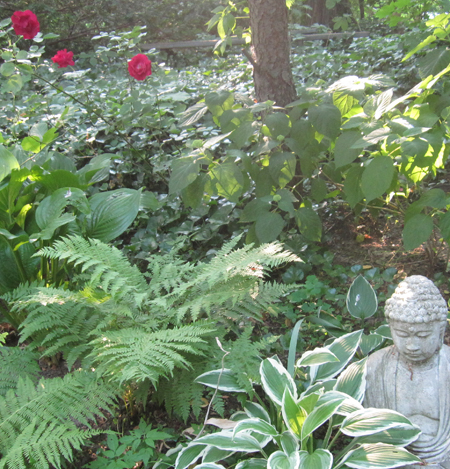
When we moved into our home 11 years ago, the garden was completely overgrown with ivy and weed vines. I spent a few years chopping them back and finally got it to the stage where I could plant flowers. But after clearing all those vines, I also discovered a few plants from some other previous gardener, including rose bush that was situated under a tree.
Anyone who gardens knows that roses need sunlight, so it’s not surprising that my little rose never bloomed. The tree was blocking all the sunlight and the only things that thrived in that part of the garden were ferns, hostas and other shade plants. Still, I don’t like killing things (except those horrid weed vines!) so I just left it there. Every year it grew tall but every year it remained flowerless.
Then last Fall, we hired a tree service to cut back the trees around the house. I didn’t think any more about it until last week, when my rose bush suddenly burst into flower. The tree guy really didn’t cut much off that tree and yet it was obviously just enough to allow those flowers to bloom.
As I took the picture posted with this blog, I thought about how similar this is to the process I go through when writing a resume. So much of the information I learn about a client would actually obscure his or her potential if I included it in the resume. My job is to cut away the ivy and weed vines, and to shine enough light on key facts in order to help my client realize his or her potential.
I think that most people view writing a resume as an exercise in factual documentation (“I worked in this place for this many years and these were the things I did. Then I went to this place and stayed there for 3 years and here is what I did”). But it’s not that at all. It’s a selective process, a filtering process – your job when writing a resume is to determine the important information and then create a document that allows that information to shine out from the page – just like my lovely red rose bush.

Comments are closed.